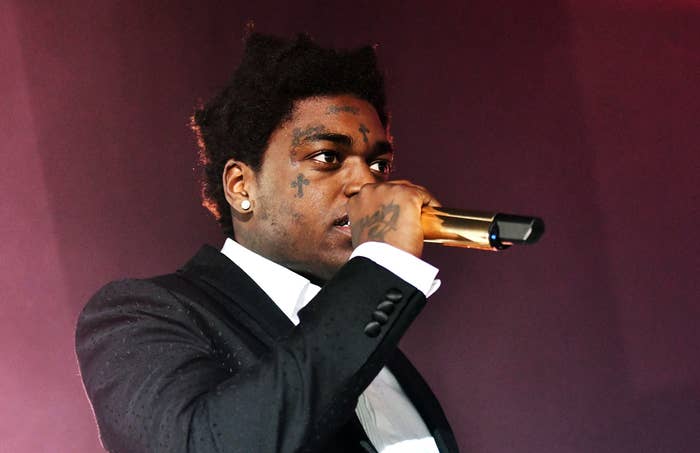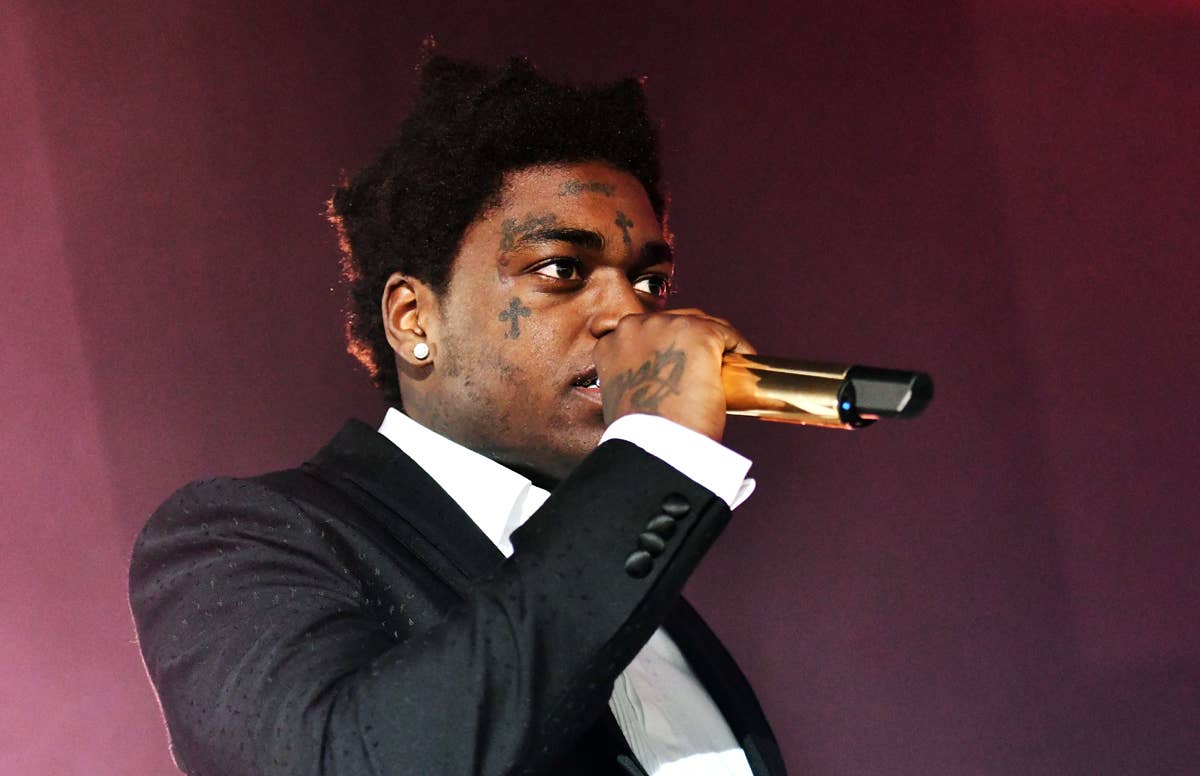
On Wednesday morning, November 13, Kodak Black appeared in a Miami courtroom and was sentenced to 46 months behind bars by Judge Federico Moreno in his weapons case. Back in August, the rapper pleaded guilty to charges stemming from an arrest during Rolling Loud in May. He was arrested just before he was supposed to perform, and the months since have seen a lot of accusations, replies, and wild headlines. But what exactly happened? How did we get here? And what’s next for Kodak?
When was he arrested?
Kodak Black was arrested as he arrived at Hard Rock Stadium in Miami Gardens, Florida on May 11, 2019. He was on his way to perform his set, scheduled for 8:45 p.m., at Rolling Loud later that night. The arrest was made by local police, ATF agents, and U.S. Marshals.
The festival said they had “no knowledge of what led to the arrest.” Local reporter Brian Entin shared a photo of Kodak in police custody.
What was he charged with?
Kodak was charged with two counts of “making a false statement in connection with the acquisition or attempted acquisition of a firearm.” The maximum penalty is 10 years behind bars (along with three years of supervised release afterwards) and a $250,000 fine.
What do authorities say he did?
Kodak’s indictment accuses him of lying to a gun dealer (Lou’s Police Distributors in Hialeah, Florida) twice: once on January 25, 2019 and once on March 1. During the first trip, he bought a Century Arms Mini Draco 7.62 x 39 Romanian pistol ($669.98), a Sig MPXK9 9mm pistol ($1,940.00), and a Sig P238 .380 pistol ($510.00), which he picked up several days later. On the March visit, he attempted to buy a Sig MCX Rattler 300 Blackout Pistol ($2,598.98) and a Glock 43x ($459.98). On that second trip, the transaction was denied.
On both of those outings, he had to fill out a form (ATF form 4473). On that form are three questions. Answering yes to any of them would have meant that Kodak couldn’t get the guns. He answered no, and the government contends that he was lying. Here are the questions:
Are you under indictment or information in any court for a felony, or any other crime for which the judge could imprison you for more than one year?
Have you ever been convicted in any court of a felony, or any other crime for which the judge could have imprisoned you for more than one year, even if you received a shorter sentence including probation?
Are you an unlawful user of, or addicted to, marijuana or any depressant, stimulant, narcotic drug, or any other controlled substance?
The biggest issue was with the first of these questions. Kodak is currently under indictment in South Carolina for first degree criminal sexual conduct. The rapper is accused of sexually assaulting a girl in a hotel room in Florence County, South Carolina after a show in November, 2016.
As for the second question about convictions, the government brought up Kodak’s extensive past record (most notably, a 2013 conviction for carjacking and robbery). And the part about controlled substances: the government pointed out that Kodak already had eight drug arrests, and had been busted with marijuana at the US/Canada border just about a month prior.
In addition to lying about the three questions, the government contends, Kodak had entered the wrong social security number on the first of the two times he filled out the form, transposing two digits. Thus, a background check didn’t reveal the South Carolina case. He entered the correct social security number the second time. The shop then found his criminal record, and denied the transaction.
What was his defense?
When it came to lying about being under indictment, Kodak’s lawyers said that the government “sets forth no evidence that [Kodak] intended to deceive or knew that the alleged statement was intended to deceive”—in short, that he wasn’t actually trying to fool anyone. As for the part about prior convictions, they said that in the 2013 case he “was never adjudicated a felon, but rather a delinquent and youthful offender.” And when it came to controlled substances, they argued, he was not an unlawful user of marijuana, because he has a medical marijuana prescription. Also, his mother “has never witnessed her son use illegal drugs.”
What happened after he was arrested?
Four days after his arrest, Kodak had a hearing where a judge said he could be free on a $500,000 bond. The government didn’t like that, and asked that Kodak remain imprisoned while they appealed the decision. The judge agreed.
Two days later, Kodak lost his appeal hearing and had to remain behind bars. The main thrust of the government’s argument during the appeal was that Kodak was a danger to the community. Two of the guns he bought at Lou’s, they said, were found at different crime scenes. The Sig MPXK9 was located on the scene of a March 2019 shooting in Pompano Beach, Florida. The gun had Kodak’s fingerprints on it, and a live round in the chamber. The intended victim in the case was reportedly a rap rival of Kodak’s. The Mini Draco was found when Kodak was arrested at the Canadian border incident mentioned above.
All of this was enough to convince the judge that Kodak should remain locked up while the case is adjudicated. “I think he's a danger to the community because he wants to have access to guns for whatever reason,” Judge Frederico A. Moreno ruled. “[N]o condition will reasonably assure the appearance of this defendant and the safety of...the community.”
What did he plead guilty to?
On August 14, Kodak’s lawyers filed for a “change of plea” hearing—a clue that they were planning on changing their stance after months of maintaining innocence. Then he pleaded guilty to two counts of knowingly making a false and fictitious written statement in connection with the acquisition and attempted acquisition of a firearm from a federally licensed firearms dealer.
Kodak admitted to lying in his answer to the first of the three questions: “Are you under indictment or information in any court for a felony, or any other crime for which the judge could imprison you for more than one year?” The government also confirmed that one of the guns Kodak purchased in January had been used in the Pompano Beach shooting.
What happened at the sentencing?
Kodak faced a maximum of 10 years in prison, followed by three years of supervised release. The government determined that Kodak faced a guideline imprisonment range (a recommended range of prison time based on the severity of the crime and his own criminal history) of 46 months to 57 months. His lawyers disagreed for technical reasons, and instead said that the guideline range was 37 to 44 months. Either way, the government said that whatever the range turns out to be, they would recommend that Kodak be sentenced at the low end of it. Kodak’s lawyers, unsurprisingly, asked for a sentence lower than the guideline range. Those guidelines were just that—guidelines. There was not a mandatory minimum sentence for this case. The judge had the final word, and could have gone below the guideline range. However, in the end, he went with exactly what the government requested—the low end of the guideline range, 46 months.
The government determined a guideline imprisonment range of 46 months to 57 months.
Kodak’s attorneys had a number of reasons for requesting a lower sentence, which they laid out in a fifteen page letter “memorandum in aid of sentencing” that they filed with the court on November 8. They say that Kodak wanted to plead guilty immediately, against their advice, so he could “take responsibility for all of the charges he was indicted on.” The lawyers also claim that they administered a lie detector test on Kodak to determine if he bought the weapons for self defense, and his answer of yes was “marked as 99.9% truthful.” They also mention that Kodak had received “legitimate and very public death threats by known gangs and gang members.”
The memorandum delves into Kodak’s background, painting him as a “victim and product of his environment” who had repeated run-ins with the criminal justice system. It mentions a “highly impressionable and heavily troubled young man being led astray by environmental pressures and influences.” And most interestingly, the lawyers mention Kodak's charitable efforts. Many of those have been publicly reported, but the attorneys also claim that Kodak “anonymously donates to just [sic] many families of officers that have died in the line of duty.”
What's next?
In addition to this sentence, Kodak still has to deal with his criminal sexual conduct case in South Carolina, which is still pending. Kodak is technically out on bond for that case, though a motion was made a few months ago to revoke that bond. A search of court records shows that no hearings in the case are currently scheduled. Complex has reached out to Kodak's attorneys to see if they plan to appeal, but have not yet received a response.

